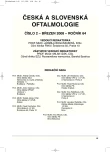The Presence of Dry Eye Syndrome and Corneal Complications in Patients with Rheumatoid Arthritis and its Association with -174 Gene Polymorphism for Interleukin 6
Authors:
V. Polanská 1; O. Šerý 2; Z. Fojtík 3; Z. Hlinomazová 1
Authors‘ workplace:
Oční klinika LF MU a FN, Brno, přednostka prof. MUDr. Eva Vlková, CSc.
1; Ústav biochemie, Přírodovědecká fakulta MU, Brno, vedoucí pracoviště doc. Ing. Martin Mandl, CSc.
2; II. interní klinika LF MU a FN, Brno, přednosta prof. MUDr. Jiří Vorlíček, CSc.
3
Published in:
Čes. a slov. Oftal., 64, 2008, No. 2, p. 77-80
Overview
The aim of this study was to evaluate the presence of the dry eye syndrome and corneal complications in patients with rheumatoid arthritis and to assess its association with the –174 gene polymorphism for interleukin 6.
The group consisted of 123 patients treated for rheumatoid arthritis (20 men, 103 women); the mean age was 53 years (± 13.6).
Every patient had completely ophthalmologic examination and special attention was paid to the amount of tears. The presence of corneal complications was detected in the medical history and evaluated during the slit lamp examination. In all patients the polymorphism-174 IL-6 examinations were performed. For the statistical data processing, the chi square (χ²) test for nominal variable was used.
The dry eye syndrome (DES) was found in 98 eyes (79.7 %), severe dry eye syndrome was detected in 53 patients (43.1 %). Corneal complications appeared in 9 patients (7.3 %). DES was present in 32 patients with the GG genotype (91.4 %, n₁ = 35), in 49 patients with the CG genotype (71.0 %, n₂ = 69), and in 8 patients with the CC genotype (42.1 %, n₃ = 19). After the statistical evaluation we have found the association between the dry eye syndrome and the GG genotype (χ² = 8.9) and the association between less common dry eye syndrome appearance and the presence of the CC genotype (χ² = 10.3). Severe dry eye syndrome we proved in 18 patients with GG genotype (51.4 %, n₁ = 35), in 31 patients with CG genotype (44.9 %, n₂ = 69), and in 4 patients with CC genotype CC (21.1%, n₃ = 19). We proved statistically significant association between CC genotype and less often appearance of the severe dry eye syndrome (χ²= 4.45). Corneal complications we noticed in one patient with GG genotype (2.8 %, n₁ = 35), in 5 patients with CG genotype (7.2 %, n₂= 69), and in 3 patients with CC genotype (15.8 %, n₃= 19). We did not prove statistically significant association between the 174 IL –6 polymorphism and corneal complications appearance.
The 174 IL-6 polymorphism influences the appearance of the dry eye syndrome. In patients with GG genotype of the -174 gene polymorphism for IL -6 is its appearance more common. Patients with the rheumatoid arthritis and with CC genotype of the -174 gene IL-6 polymorphism have lower frequency of the dry eye syndrome presence.
Key words:
rheumatoid arthritis, dry eye syndrome, corneal complications, polymorphism, interleukin 6
Sources
1. Bhadoria, D.,P., Bhadoria, P., Sundaram, K.R. et al.: Ocular manifestation in rheumatoid arthritis. Journal of the Indian Medical Association, 87, 1989: 134–135.
2. Bogliolo, A., Mela, Q., Perpignano, L. et al.: Ocular involvement in rheumatoid arthritis. Clinica Terapeutica, 142, 1993: 41–46.
3. Cuenca,J., Cuchacovich, M., Peréz, C. et al.: The -308 polymorphism in the tumour necrosis factor fene promotor region and ex vivo lipopolysacharide –induced TNF expression and cytotoxic activity in Chilean patinets with rheumatoid arthritis. Rheumatology, 42, 2003: 308–313.
4. Harper, S. L., Foster, C. S.: The ocular manifestations of rheumatoid disease. International Ophthalmology Clinics., 38, 1998: 1–19.
5. Choy, E. H., Panayi, G. S.: Cytokine pathways and joint inflammation in rheumatoid arthritis. New England Journal of Medicine, 344, 2001: 907–916.
6. Choy, E.: Interleukin 6 receptor as a target for the treatment of rheumatoid arthritis. Annals of the Rheumatic Diseases, 62, 2003: 68–69.
7. Klener, P. et al.: Vnitřní lékařství. Galen, 2001: 813–822.
8. Pavelka, K.: Biologická léčba revmatoidní artritidy a dalších revmatických onemocnění. Remedia, 5, 2005: 53–65.
9. Pavelka, P., Rovenský, J.: Klinická revmatologie. Galen, 2002: 181–215
10. Pawlik, A., Czerny, B., Dabrowska-Zamojcin, E. et al.: The influence of IL-6 polymorphism on efficacy of treatment of rheumatoid arthritis patients with methotrexate and prednisone. Polskie Archiwum Medycyny Wewnetrznej, 114, 2005: 843–847.
11. Pflugfelder, S. C., Jones, D., Ji, Z. et al.:. Altered cytokine balance in the tear fluid and conjunctiva of patients with Sjőgren’s syndrome keratoconjunctivitis sicca. Curr. Eye Res., 19, 1999: 201–211.
12. Prada, J., Noelle, B., Baatz, H. et al.: Tumour necrosis factor alpha and interleukin 6 gene expression in keratocytes from patients with rheumatoid corneal ulcerations. Brit. J. Ophthalmol., 87, 2003: 548–550.
13. Robak, T., Gladalska, A., Stepie, H. et al.: Serum levels of interleukin-6 type cytokines and soluble interleukin-6 receptor in patients with rheumatoid arthritis. Mediators of Inflammation, 5, 1998: 347–353.
14. Sankar, V., Brennan, M. T., Kok, M. R. et al.: Etanercept in Sjőgren’s syndrome: a twelve-week randomized, double-blind, placebo-controlled pilot clinical trial. Arthritis & Rheumatism. 50, 2004: 2240–2245.
15. Šerý, O., Hladilová, R., Novotný, M. et. al.: Association between -174 G/C polymorphism of interleukin-6 gene and alcoholism. Acta Neuropsychiatrica, 15, 2003: 257–261.
16. Turner, K., Pflugfelder, S. C., Ji, Z. et al.: Interleukin-6 levels in the conjunctival epithelium of patients with dry eye disease treated with cyclosporine ophthalmic emulsion. Cornea, 19, 2000: 492–496.
Labels
OphthalmologyArticle was published in
Czech and Slovak Ophthalmology

2008 Issue 2
Most read in this issue
- The Application of the Autologous Serum Eye Drops Results in Significant Improvement of the Conjunctival Status in Patients with the Dry Eye Syndrome
- Treatment for Recurrent Pterygium
- Spontaneous Premacular Hemorrhage
- Applying the DNA Diagnostics in Patients with Superficial Keratitis of Viral Origin
